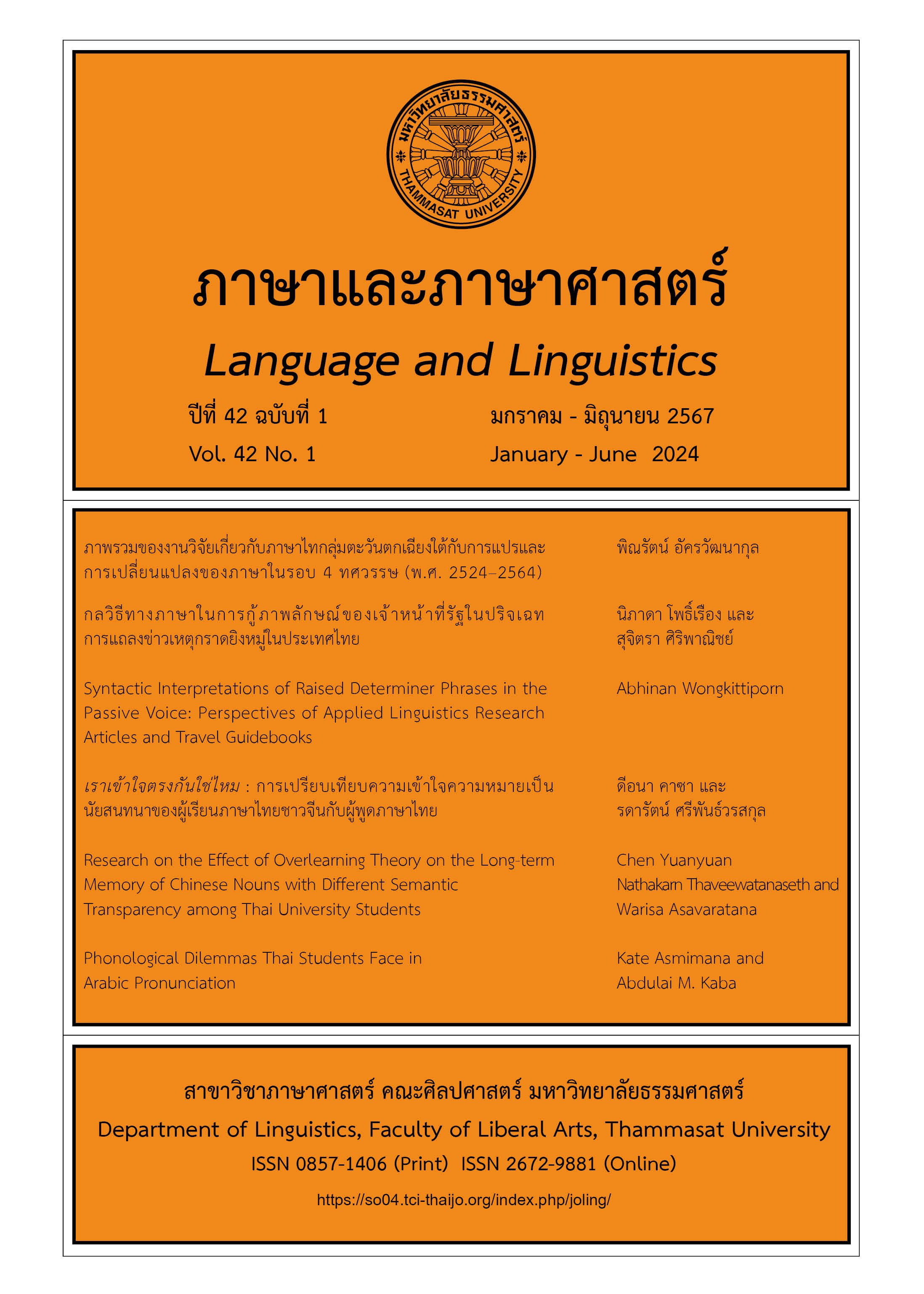Are we on the same page?: Comparing Comprehension of Implicatures by Chinese learners of Thai and Native Speakers of Thai
Main Article Content
Abstract
For L2 learners, comprehension of conversational implicature is one of the most challenging tasks because learners must interpret the intended meaning based on context. If the learners infer meanings incorrectly, it might lead to misunderstandings between interlocutors. This research aims to investigate implicature comprehension in Chinese learners of Thai by comparing their comprehension with native speakers of Thai across different types of implicature. The focus of this research is the implicature caused by flouting a maxim based on Grice’s (1975) paradigm. A total of 50 Chinese learners of Thai and 30 native speakers of Thai completed a questionnaire with multiple-choice answers. The results show that Chinese learners of Thai comprehend implicated messages significantly less than native speakers of Thai. The results also revealed that comprehension of implicatures based on flouting the Relevance maxim were easy for L2 learners while comprehension of implicatures based on flouting the Quality maxim caused the most misunderstandings. It can be assumed that the distance between intended meaning and literal meaning is a crucial factor in interpreting implicature.
Article Details

This work is licensed under a Creative Commons Attribution-NonCommercial-NoDerivatives 4.0 International License.
บทความทุกบทความเป็นลิขสิทธิ์ของภาษาและภาษาศาสตร์
References
จันทิมา หวังสมโชค. (2549). กลวิธีสื่ออารมณ์ขันในละครตลกสถานการณ์ของไทยจากมุมมองวัจนปฏิบัติศาสตร์. วารสารศิลปศาสตร์, 6(2), 100-127.
จินดารัตน์ ธรรมรงวุทย์. (2553). ข้อบกพร่องเชิงวัจนปฏิบัติศาสตร์ในการสื่อสารระหว่างวัฒนธรรม:กรณีศึกษาการใช้ภาษาไทยของผู้พูดชาวอเมริกันและชาวจีน [วิทยานิพนธ์ปริญญามหาบัณฑิต]. มหาวิทยาลัยธรรมศาสตร์.
ฐิติภา คูประเสริฐ และ สมชาย สําเนียงงาม. (2562). การนําเสนอภาพลักษณ์ของบุคคลสาธารณะด้วยการละเมิดหลักความสัมพันธ์ในการตอบคําถามเกี่ยวกับกรณีความขัดแย้ง. วารสารศิลปศาสตร์ มหาวิทยาลัยรังสิต, 14(2), 21-38.
ณัฐพร พานโพธิ์ทอง. (2555). เอกสารคำสอนรายวิชา 2201783 การวิเคราะห์ภาษาไทยตามแนววัจนปฏิบัติศาสตร์ (ฉบับปรับปรุง). ภาควิชาภาษาไทย คณะอักษรศาสตร์ จุฬาลงกรณ์มหาวิทยาลัย.
ดีอนา คาซา. (2564). การปฏิสัมพันธ์ของชาวอินโดนีเซียที่ใช้ภาษาไทยเป็นภาษาที่สองกับชาวไทย: การศึกษาตามแนววัจนปฏิบัติศาสตร์อันตรภาษาและวัจนปฏิบัติศาสตร์ระหว่างวัฒนธรรม [วิทยานิพนธ์ปริญญาดุษฎีบัณฑิต]. จุฬาลงกรณ์มหาวิทยาลัย.
ยางวอน ฮยอน. (2559). การศึกษากลวิธีแสดงความเห็นแย้งของนักศึกษาเกาหลีที่พูดภาษาไทยเป็นภาษาที่ 2 ในการสนทนาแบบแสดงความคิดเห็นในภาษาไทยตามแนววัจนปฏิบัติศาสตร์อันตรภาษา. ภาษาและภาษาศาสตร์, 34(2), 1-19.
ยางวอน ฮยอน. (2560). การปฏิสัมพันธ์ของชาวเกาหลีที่ใช้ภาษาไทยและชาวไทยในปริบทธุรกิจ: การศึกษาตามแนววัจนปฏิบัติศาสตร์อันตรภาษาและวัจนปฏิบัติศาสตร์ระหว่างวัฒนธรรม [วิทยานิพนธ์ปริญญาดุษฎีบัณฑิต]. จุฬาลงกรณ์มหาวิทยาลัย.
รดารัตน์ ศรีพันธ์วรสกุล. (2562). การศึกษาวัจนกรรมการแสดงความเห็นแย้งของผู้เรียนภาษาไทยชาวจีนตามแนววัจนปฏิบัติศาสตร์อันตรภาษา: กรณีศึกษานักศึกษาชาวจีนจากมณฑลยูนนานและกวางสี [วิทยานิพนธ์ปริญญามหาบัณฑิต]. จุฬาลงกรณ์มหาวิทยาลัย.
รดารัตน์ ศรีพันธ์วรสกุล. (2565). การศึกษาวัจนกรรมการแสดงความไม่พอใจตามแนววัจนปฏิบัติศาสตร์ภาษาระหว่างกลาง: กรณีศึกษาผู้เรียนภาษาไทยชาวจีน. ภาษาและภาษาศาสตร์, 40(2), 89-114.
รังสินีย์ ซื่อเกียรติขจร, นราวัลย์ พูลพิพัฒน์, และ สนิท สัตโยภาส. (2562) การศึกษา วัจนกรรมที่ปรากฏในบทสนทนาของชาวต่างประเทศที่ฝึกพูดภาษาไทย. พิฆเนศวร์สาร, 15(1), 11-18.
สำนักข่าวอิศรา. (2566). 10 ปี จีนอันดับหนึ่ง! ส่องสถิติ น.ศ.ต่างชาติในไทยปี 55-65 เมียนมาครองเบอร์สอง. สืบค้น 5 ตุลาคม 2566, จาก https://www.isranews.org/article/isranews-scoop/115794-isranews-09.html
สิริญญา สุขสวัสดิ์. (2558). ลักษณะภาษาและกลวิธีการใช้ภาษาตามแนววัจนปฏิบัติศาสตร์ ในหน้าแฟนเพจ ข้อความโดนๆ ในเฟซบุ๊ก [วิทยานิพนธ์ปริญญามหาบัณฑิต]. มหาวิทยาลัยเชียงใหม่.
สุพิชญา มั่นคง. (2552). การกล่าวเลี่ยงในภาษาไทยและภาษาอังกฤษแบบอเมริกัน. วารสารศิลปศาสตร์, 9(1), 21-47.
อุมาภรณ์ สังขมาน. (2559). กลวิธีทางภาษาในวัจนกรรมเสียดสีเพื่อสร้างความตลกขบขันของไทย. วารสารมนุษยศาสตร์, 23(1), 154-178.
Zheng, W., รัชนีย์ญา กลิ่นน้ำหอม และ วิสันต์ สุขวิสิทธิ์. (2556). “ผมไม่ว่างครับ”: การศึกษาเปรียบเทียบกลวิธีการปฏิเสธการขอร้องของอาจารย์ระหว่างนักศึกษาไทยกับนักศึกษาจีน. วารสารวจนะ, 1(2), 61-72.
Bouton, L. F. (1988). A cross-cultural study of ability to interpret implicatures in English. World Englishes, 7(2), 183-196.
Bouton, L. F. (1990). The effective use of implicature in English: Why and how it should be taught in the ESL classroom. In L. F. Bouton & Y. Kachru (Eds.), Pragmatics and Language Learning: Monograph Series (pp. 43-52). University of Illinois.
Bouton, L. F. (1992). The interpretation of implicature in English by NNS: Does it come automatically without being explicitly taught? In L. F. Bouton (Ed.), Pragmatics and language learning: Monograph series Vol.3 (pp. 66-77). University of Illinois.
Bouton, L. F. (1994). Conversational implicature in a second language: Learned slowly when not deliberately taught. Journal of Pragmatics, 22(2), 157-167.
Bouton, L. F. (1999). Developing nonnative speaker skills in interpreting conversational implicatures in English. Culture in Second Language Teaching and Learning, 30(1), 47-70.
Cook, M., & Liddicoat, A. J. (2002). The development of comprehension in interlanguage pragmatics: The case of request strategies in English. Australian Review of Applied Linguistics, 25(1), 19-39
Grice, H. P. (1975). Logic and conversation. In P. Cole & J. L. Morgan (Eds.), Syntax and semantics: Vol. 3. Speech acts (pp. 41-58). Brill.
Kanchina, Y., & Deepadung, S. (2019). Request modifications used by Chinese learners and native speakers of Thai. Journal of the Southeast Asian Linguistics Society, 12(1), 83-112.
Kavetska, A. A. (2021). Factors influencing the comprehension of conversational implicatures by native and non-native speakers of English: an empirical study inspired by Bouton’s (1988). Forum for Contemporary Issues in Language and Literature, 2, 35-49.
Keenan, E. O. (1976). The universality of conversational postulates. Language in society, 5(1), 67-80.
Koike, D. A. (1995). Transfer of pragmatic competence and suggestions in Spanish foreign language learning.” In S. Gass & j. Neu (Eds.), Speech acts across cultures (pp. 257-281). Mouton de Gruyter.
Li, Q. (2016). Conversational implicature in English listening comprehension Teaching. Theory and Practice in Language Studies, 6(10), 2024-2051.
O'Connell, S. P. (2019). Comprehension of conversational implicature: examining evidence of Its separability as a listening subskill (publication No. 22583728) [Doctoral thesis, University of Maryland]. Proquest Dissertation and Thesis Global.
Roever, C. (2005). Testing EFL pragmatics. Peter Lang.
Student. (1908). The probable error of a mean. Biometrika, 6(1), 1-25.
Taguchi, N. (2005). Comprehension of implied meaning in English as a second language. The Modern Language Journal, 89(4), 543-562.
Taguchi, N. (2008). Pragmatic comprehension in Japanese as a foreign language. The Modern Language Journal, 92(4), 558-576.
Taguchi, N. (2013). Comprehension of conversational implicature: What response times tell us. In N. Taguchi & J. M. Sykes (Eds.), Technology in interlanguage pragmatics research and teaching (pp. 19-41). John Benjamins.
Taguchi, N., Li, S., & Liu, Y. (2013). Comprehension of conversational implicature in L2 Chinese. Pragmatics & Cognition, 21(1), 139-157.
Verschueren, J. (2012). Ideology in language use: Pragmatic guidelines for empirical research. Cambridge University Press.
Yamanaka, J. (2003). Effects of proficiency and length of residence on the pragmatic comprehension of Japanese ESL learners. Second Language Studies, 22(1), 107-175.


